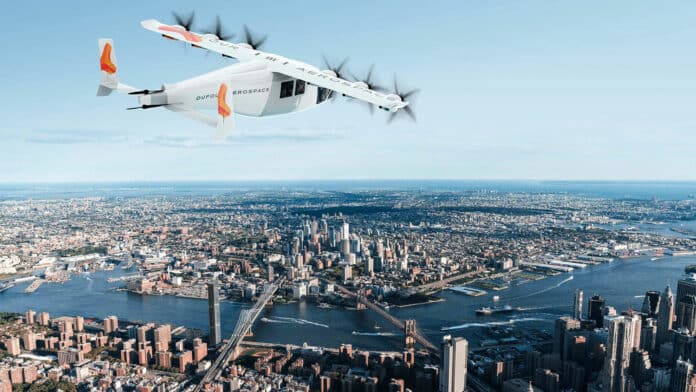An eVTOL aircraft developer Dufour Aerospace has successfully completed a Series B investment from Vista Global Holding Limited (Vista), the world’s leading global private aviation group, further supporting the continued development of sustainable aviation technologies.
In its latest announcement, the Swiss-based start-up confirmed that Vista has joined the existing investors and two new investors in providing an undisclosed capital investment. The new funding will provide valuable support in expanding the considerable potential of Dufour’s innovative tilt-wing technologies and aerospace products. This technology will be applied in Dufour’s unmanned Aero2 aircraft, and its flagship manned Aero3 aircraft.
The Aero 3 is an eight-seat, piloted eVTOL that can carry 750 kilograms (1,650 pounds) of payload to distances of up to 551 nautical miles (1020 km), cruising at a speed of 189 knots (350 km/h). The company plans to offer this eVTOL aircraft for emergency medical transportation as well as private air taxi operations.
The manned Aero3 features a tilt-wing design and hybrid propulsion system incorporated in a design that’s adapted for passenger transportation. It combines the best features of the worlds of both helicopters and airplanes. Aero3 is capable of taking off and landing like a helicopter while being as energy efficient and fast as an airplane in cruise flight. The aircraft is expected to achieve type certification in 2025, with deliveries beginning in 2026.
The smaller Aero2 is an autonomous VTOL tilt-wing drone that can carry up to 40 kg (88 pounds) of payload. This aircraft is an excellent fit for search and rescue (SAR) operations, long-endurance terrain and infrastructure surveillance, and transporting cargo to remote and urban areas.
The Aero2 boasts the same main features as the Aero3. It has only four propellers mounted on the wings, while the Aero3 has a distributed electric propulsion system with six main propellers mounted on the front of a tilting wing and two additional vertical lift propellers mounted on the tail. The Aero2 has a much shorter range of 216 nm(400 km) and a slower cruise speed of 92 knots (170 km/h). The Aero 2 is expected to achieve type certification in 2024, with the first deliveries to follow in 2025.
